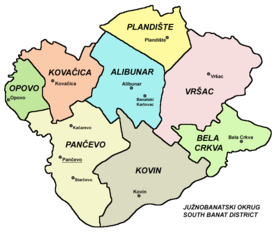South Banat District
South Banat District
Јужнобанатски округ Južnobanatski okrug Dél-bánsági körzet Districtul Banatul de Sud Juhobanátsky okres | |
|---|---|
|
Images from the South Banat District | |
 Location of the South Banat District within Serbia | |
| Coordinates: 44°52′N 20°38′E / 44.867°N 20.633°E | |
| Country | |
| Province | |
| Administrative center | Pančevo |
| Government | |
| • Commissioner | Marina Toman (SNS) |
| Area | |
• Total | 4,245 km2 (1,639 sq mi) |
| Population (2022 census) | |
• Total | 260,244 |
| • Density | 61/km2 (160/sq mi) |
| ISO 3166 code | RS-04 |
| Municipalities | 8 (2 cities) |
| Settlements | 94 |
| - Cities and towns | 10 |
| - Villages | 84 |
| Website | juznobanatski |


The South Banat District (Serbian: Јужнобанатски округ, romanized: Južnobanatski okrug, pronounced [jûʒnobǎnaːtskiː ôkruːɡ]; Hungarian: Dél-bánsági körzet; Romanian: Districtul Banatul de Sud; Slovak: Juhobanátsky okres) is one of seven administrative districts of the autonomous province of Vojvodina, Serbia. The administrative center of the district is the city of Pančevo. The district lies in the region of Banat. According to the 2022 census results, it has a population of 260,244 inhabitants.[1]
Name
[edit]In Serbian, the district is known as Južnobanatski okrug (Јужнобанатски округ), in Croatian as Južnobanatski okrug, in Hungarian as Dél-bánsági körzet, in Slovak as Juhobanátsky okres, in Romanian as Districtul Banatul de Sud, and in Rusyn as Јужнобанатски окрух.
Municipalities
[edit]It encompasses the cities of Pančevo and Vršac and the following municipalities:
Demographics
[edit]| Year | Pop. | ±% |
|---|---|---|
| 1948 | 279,092 | — |
| 1953 | 291,125 | +4.3% |
| 1961 | 320,187 | +10.0% |
| 1971 | 331,285 | +3.5% |
| 1981 | 340,189 | +2.7% |
| 1991 | 328,428 | −3.5% |
| 2002 | 313,937 | −4.4% |
| 2011 | 293,730 | −6.4% |
| 2022 | 260,244 | −11.4% |
| Source: [2] | ||
According to the census done in 2011, the South Banat District has 293,730 inhabitants.
Ethnic groups
[edit]Most of the municipalities in the district have an ethnic Serb majority, while the municipality of Kovačica is ethnically mixed, with a relative Slovak majority (41.8%). Ethnic composition of the South Banat district:[3]
| Ethnic group | Population | % |
|---|---|---|
| Serbs | 208,462 | 70.97% |
| Romanians | 18,000 | 6.13% |
| Slovaks | 13,777 | 4.69% |
| Hungarians | 13,194 | 4.49% |
| Romani | 8,025 | 2.73% |
| Macedonians | 6,548 | 2.23% |
| Croats | 1,512 | 0.51% |
| Yugoslavs | 1,178 | 0.40% |
| Montenegrins | 921 | 0.31% |
| Bulgarians | 757 | 0.26% |
| Muslims | 586 | 0.20% |
| Germans | 472 | 0.16% |
| Slovenes | 358 | 0.12% |
| Albanians | 250 | 0.09% |
| Russians | 184 | 0.06% |
| Bosniaks | 144 | 0.05% |
| "Vlachs" (Romanians) | 123 | 0.04% |
| Others | 19,239 | 6.55% |
| Total | 293,730 |
Culture
[edit]Pančevo is distinguished for its numerous cultural monuments, such as Vojlovica Monastery, founded by Despot Stefan Lazarević in 1405. Religious monuments also include the Serbian Orthodox Church of Assumption (built in 1807-1811), the Church of Transfiguration (built in 1873-1878), and the Roman Catholic Church of St Charles Borromeo (from 1756/57).[4] Prominent cultural institutions include Pančevo National Museum (founded in 1923) and Pančevo Cultural Center.[5][6]
In the town of Vršac, there are two Serbian Orthodox monasteries: Mesić Monastery from the 13th century and Središte Monastery from the late 15th century. Vršac is also home to the medieval fortress Vršac Castle (Vršačka kula), which dates back to the mid 15th century.[7] Vršac Museum (founded in 1882) is located in the historic Konkordija building and is one of the oldest museums in Serbia.[8]
Idvor village is the birth place of Mihajlo Pupin, Serbian physicist, inventor, author and philanthropist. Pupin Memorial Complex includes his family house, the elementary school he attended, and the National Home that he endowed to ldvor and its people.[9][10]
Archeological sites of exceptional cultural significance are Starčevo from the Neolithic and Židovar from the Bronze Age.[11]
See also
[edit]- Administrative divisions of Serbia
- Districts of Serbia
- Former Temes and Torontál counties of Lands of the Crown of Saint Stephen
References
[edit]- ^ "Census 2022 - excel table | ABOUT CENSUS". popis2022.stat.gov.rs. Retrieved 2024-07-21.
- ^ "2011 Census of Population, Households and Dwellings in the Republic of Serbia" (PDF). stat.gov.rs. Statistical Office of the Republic of Serbia. Retrieved 16 January 2017.
- ^ "Попис становништва, домаћинстава и станова 2011. у Републици Србији" (PDF). stat.gov.rs. Republički zavod za statistiku. Retrieved 16 January 2017.
- ^ Ćirić, Gordana (2015-03-01). "Манастири и Цркве". Град Панчево (in Serbian). Retrieved 2024-07-17.
- ^ "Народни музеј Панчево". МУЗЕЈ. 2022-03-08. Retrieved 2024-07-17.
- ^ "Kulturni Centar Pančeva". www.kulturnicentarpanceva.rs. Retrieved 2024-07-17.
- ^ "TOV - Turistička Organizacija Vršac". TOV - Turistička Organizacija Vršac. Retrieved 2024-07-18.
- ^ "О музеју". Vršac (in Serbian). Retrieved 2024-07-18.
- ^ "Музеј Пупина". www.muzejpupina.rs. Retrieved 2024-07-21.
- ^ "The Memorial Complex of Mihajlo Pupin". Завод за заштиту споменика културе у Панчеву. Retrieved 2024-07-21.
- ^ "Home". Завод за заштиту споменика културе у Панчеву. Retrieved 2024-07-17.
Note: All official material made by Government of Serbia is public by law. Information was taken from official website.












